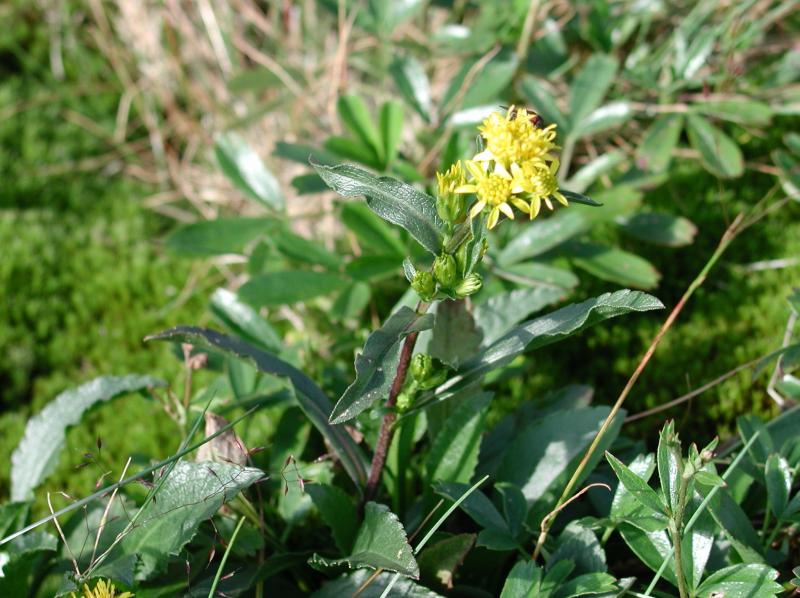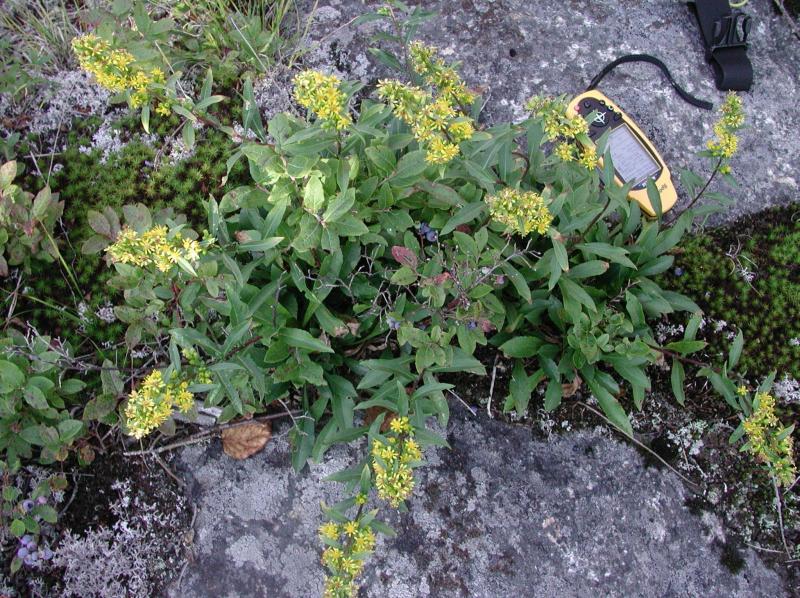Alpine Goldenrod
Solidago leiocarpa DC
- Class
- Dicotyledoneae (Dicots)
- Family
- Asteraceae (Aster Family)
- State Protection
- Threatened
Listed as Threatened by New York State: likely to become Endangered in the foreseeable future. For animals, taking, importation, transportation, or possession is prohibited, except under license or permit. For plants, removal or damage without the consent of the landowner is prohibited.
- Federal Protection
- Not Listed
- State Conservation Status Rank
- S2
Imperiled in New York - Very vulnerable to disappearing from New York due to rarity or other factors; typically 6 to 20 populations or locations in New York, very few individuals, very restricted range, few remaining acres (or miles of stream), and/or steep declines.
- Global Conservation Status Rank
- G3
Vulnerable globally - At moderate risk of extinction due to rarity or other factors; typically 80 or fewer populations or locations in the world, few individuals, restricted range, few remaining acres (or miles of stream), and/or recent and widespread declines.
Summary
Did you know?
Alpine goldenrod is endemic to northeastern North America. It only occurs in alpine habitats from Quebec through northern New England and New York. The species name refers to smooth (leio) fruit (carpa) but the fruit are actually hairy.
State Ranking Justification
There are 13 known extant populations. There are also two historical populations which have not been seen for over 100 years. Still, more survey work is needed at these two sites to determine if the plants are still there. All the populations are restricted to very limited habitat in the relatively small area of the high peaks region of the Adirondacks. At least 10 of the populations are partially threatened by trampling from hiker traffic.
Short-term Trends
Trampling by hiker traffic has probably reduced some of the populations a little, but no clear data is available. Eight populations were first documented within the past 20 years. These populations were probably overlooked in the past and are likely not the result of new dispersal events. No population is known to have become extirpated in the past 25 years. Overall, short-term trends are unclear but there may have been a very small decline.
Long-term Trends
There are two historical populations which have not been seen in over 100 years. One of these populations was looked for a few times without success but there is much available habitat and further survey work is needed before this population can be deemed extirpated. The second historical population also needs further survey work to determine if it has persisted.
Conservation and Management
Threats
Most populations are threatened by trampling and erosion caused by hiker traffic but the extent of the damage is unknown. Part of one population is threatened by roadside disturbances.
Conservation Strategies and Management Practices
The Summit Steward program, which works to inform hikers of the fragile nature of alpine plants, is a critical program which is helping to reduce trampling of alpine vegetation. This program and other efforts designed to reduce trampling of alpine meadows are needed.
One of the populations is threatened by road disturbances. All road work near this population needs to be done without damaging the population. Therefore, communication with the group responsible for maintaining this road is needed.
Research Needs
The two historical populations need further survey work to assess their condition. Consistent and regular estimates of population sizes are needed for all populations.
Habitat
Habitat
In New York, this species is restricted to a few of the highest summits in the high peaks region of the Adirondacks. It grows in alpine meadows, often with abundant exposed bedrock, and sometimes surrounded by krummholz and spruce-fir forests (New York Natural heritage Program 2007). Alpine habitats (Semple and Brooks 2006).
Associated Ecological Communities
- Cliff community*
(guide)
A community that occurs on vertical exposures of resistant, non-calcareous bedrock (such as quartzite, sandstone, or schist) or consolidated material; these cliffs often include ledges and small areas of talus.
- Open alpine community
(guide)
An open community consisting of a mosaic of sedge/dwarf shrub meadows, dwarf heath shrublands, small boggy depressions, and exposed bedrock covered with lichens and mosses. The open alpine community occurs above timberline (about 4,900 ft or 1,620 m) on the higher mountain summits and exposed ledges of the Adirondacks. The flora includes arctic-alpine species that are restricted (in New York) to these areas, as well as boreal species that occur in forests and bogs at lower elevations. The soils are thin and organic, primarily composed of peat derived from peat mosses (Sphagnum spp.) or black muck. The soils are often saturated because they can be recharged by atmospheric moisture.
* probable association but not confirmed.
Associated Species
- Agrostis mertensii (northern bent)
- Anthoxanthum monticolum ssp. orthanthum
- Carex bigelowii
- Cetraria islandica
- Diapensia lapponica (pincushion-plant, diapensia)
- Empetrum eamesii ssp. atropurpureum
- Empetrum nigrum ssp. hermaphroditum
- Huperzia appressa (mountain firmoss)
- Juncus trifidus
- Minuartia groenlandica
- Prenanthes boottii
- Salix uva-ursi (bearberry willow)
- Trichophorum cespitosum ssp. cespitosum (deer's-hair club sedge)
- Vaccinium boreale (northern lowbush blueberry)
- Vaccinium uliginosum (bog bilberry)
Range
New York State Distribution
In New York, this species is limited to a few of the highest summits and a few slightly lower cliffs in the high peaks region of the Adirondacks.
Global Distribution
This species is limited to alpine regions from Quebec south through northern New England and New York.
Identification Comments
General Description
Alpine goldenrod is a small perennial herb of alpine areas. It is related and somewhat similar to other more widespread goldenrod species. There are one to five, 2 to 14 inch tall stems arising from the base of the plants. There are leaves at the base of the plants and a few scattered along the stems. The lower leaves are .8 to 6 inches long and have rounded teeth along their edges, while the upper leaves are .8 to 1.5 inches long and entire. The flowers occur in dense clusters or heads. There are about 2 to 50 (although sometimes as many as 160) heads per plant. The flowers are yellow. Like those of dandelions, the mature fruits have capillary hairs that aid in dispersal (Semple and Cook 2006).
Identifying Characteristics
Solidago leiocarpa is often very small but it can grow up to 35 cm tall. The basal rosettes are usually withered when the plant is in flower. There are 2-7(-15) leaves on the stems, below the inflorescences. The lower and basal leaves have blades that taper into a petiole. The blades of these leaves are spatulate to oblanceolate, acute to rounded at the apices, glabrous, and crenate to serrate. The upper leaves are sessile, oblanceolate, glabrous, and entire. The inflorescences are corymbiform in small plants and corymbiform to paniculiform in larger plants. There are 2-50(-160) flowers per head. The involucres are 5.0-7.5 mm long and the fruits (cypselae) are 1.0-2.5 mm long (Fernald 1970, Semple and Cook 2006).
Best Life Stage for Proper Identification
It is easiest to identify this plant when it is in flower but it can be identified adequately when it is in fruit. If collections are made, the entire stem should be collected including the lowermost leaves, and if possible, the roots.
Similar Species
Although some goldenrods are superficially similar, S. leiocarpa is quite distinct. The usually corymbiform inflorescences, basal leaves withering by flowering time, and 30-50(-160) flowers per head should distinguish this species from all others.
Solidago randii grows on exposed cliffs and ledges below the alpine zone but can occasionally grow fairly close to populations of S. leiocarpa. Solidago randii can be distinguished by basal leaves present at flowering time, racemiform to paniculiform inflorescences, and resinous leaves (often) and involucres.
Solidago macrophylla is common in cool forests but can occasionaly get into the alpine zone. It can be distinguished by being taller (20-105 cm tall), sometimes having basal leaves persistent at flowering time, having lower leaves acute to acuminate tipped, involucres (8.6-)9.5-11.5(-12.5) mm long, and fruits (cypselae) 1.4-4.0 mm long.
Best Time to See
This species starts to flower in mid to late July or rarely in the first half of July and the flowers persist through late August or very early September. Therefore, the best time to survey for this species is from late July through August.
- Vegetative
- Flowering
- Fruiting
The time of year you would expect to find Alpine Goldenrod vegetative, flowering, and fruiting in New York.
Alpine Goldenrod Images
Taxonomy
Alpine Goldenrod
Solidago leiocarpa DC
- Kingdom Plantae
- Phylum Anthophyta
- Class Dicotyledoneae
(Dicots)
- Order Asterales
- Family Asteraceae (Aster Family)
- Order Asterales
- Class Dicotyledoneae
(Dicots)
- Phylum Anthophyta
Additional Common Names
- Cutler's alpine goldenrod
- New England goldenrod
Synonyms
- Solidago cutleri Fern.
- Solidago multiradiata var. arctica (DC.) Fern. [misapplied]
- Solidago virgaurea var. alpina Bigelow
Comments on the Classification
Solidago leiocarpa has long been known as S. cutleri (Fernald 1970, Gleason and Cronquist 1991) but the former name is older and takes priority. Some recent authors (Kartesz 1994, Mitchell and Tucker 1997, Haines and Vining 1998) have treated this taxon as S. multiradiata var. arctica but that taxon is considered a synonym of S. multiradiata (Semple and Cook 2006). Still, S. leiocarpa is similar to and may be conspecific with S. multiradiata (Semple et al. 1999, Semple and Cook 2006). It is unclear what the correct name would be for S. leiocarpa if treated at the infraspecific rank under S. multiradiata. Solidago leiocarpa is known to hybridize with S. randii (Fernald 1970).
Additional Resources
Best Identification Reference
Gleason, Henry A. and A. Cronquist. 1991. Manual of Vascular Plants of Northeastern United States and Adjacent Canada. The New York Botanical Garden, Bronx, New York. 910 pp.
Other References
Fernald, M.L. 1950. Gray's manual of botany. 8th edition. D. Van Nostrand, New York. 1632 pp.
Haines, A. and T.F. Vining. 1998. Flora of Maine, A Manual for Identification of Native and Naturalized Vascular Plants of Maine. V.F.Thomas Co., Bar Harbor, Maine.
Holmgren, Noel. 1998. The Illustrated Companion to Gleason and Cronquist's Manual. Illustrations of the Vascular Plants of Northeastern United States and Adjacent Canada. The New York Botanical Garden, Bronx, New York.
Kartesz, John T. 1994. A synonomized checklist of the vascular flora of the United States, Canada and Greenland. Volume 1-Checklist. Volume 2-Thesaurus.
Mitchell, Richard S. and Gordon C. Tucker. 1997. Revised Checklist of New York State Plants. Contributions to a Flora of New York State. Checklist IV. Bulletin No. 490. New York State Museum. Albany, NY. 400 pp.
New York Natural Heritage Program. 2010. Biotics database. New York Natural Heritage Program. New York State Department of Environmental Conservation. Albany, NY.
New York Natural Heritage Program. 2024. New York Natural Heritage Program Databases. Albany, NY.
Reschke, Carol. 1990. Ecological communities of New York State. New York Natural Heritage Program, New York State Department of Environmental Conservation. Latham, NY. 96 pp. plus xi.
Semple, J.C. and R.E. Cook. 2006. Solidago Linnaeus. Pages 107-166 in Flora of North America Editorial Committee (Editors), Flora of North America, north of Mexico, Volume 20, Magnoliophyta: Asteridae, part 7: Asteraceae, part 2, Asterales, part 2 (Aster order). Oxford University Press, New York, NY, USA. 666pp + xxii.
Semple, J.C., G.S. Ringius, and J.J. Zhang. 1999. The Goldenrods of Ontrio: Solidago L. and Euthamia Nutt. 3rd Edition. University of Waterloo Biology Series, Number 39. University of Waterloo, Waterloo, Ontario, Canada.
Weldy, T. and D. Werier. 2010. New York flora atlas. [S.M. Landry, K.N. Campbell, and L.D. Mabe (original application development), Florida Center for Community Design and Research http://www.fccdr.usf.edu/. University of South Florida http://www.usf.edu/]. New York Flora Association http://newyork.plantatlas.usf.edu/, Albany, New York
About This Guide
Information for this guide was last updated on: December 29, 2008
Please cite this page as:
New York Natural Heritage Program. 2024.
Online Conservation Guide for
Solidago leiocarpa.
Available from: https://guides.nynhp.org/alpine-goldenrod/.
Accessed July 26, 2024.

